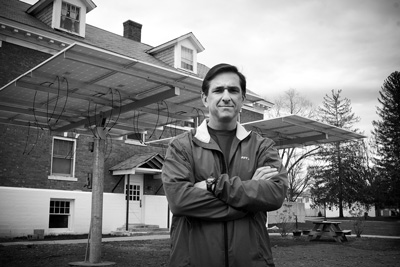News & Issues October 2015
Changing a college’s energy equation
At Green Mountain, students pursue goal of ‘net-zero’ campus
 By EVAN LAWRENCE
By EVAN LAWRENCE
Contributing writer
POULTNEY, Vt.
Steven Letendre, a professor of business, economics and environmental studies at Green Mountain College, has been working with students on a project aimed at getting the campus to “net-zero” energy status, meaning its annual power production and consumption would balance out. Tony Israel file photo
Green Mountain College already holds an impressive array of environmental credentials: second greenest school in the nation, according to the Princeton Review; No. 12 on the Sierra Club’s green college list; the first U.S. college to become climate neutral; and one of only a handful to divest fossil-fuel stocks from its endowment.
Now some students want the college to achieve another milestone – by becoming a “net-zero” energy campus.
The college already has set a goal of using 100 percent renewable energy by 2020. That’s one of a number of environmental targets laid out three years ago in the school’s “Sustainability 2020” plan.
Getting to net-zero energy consumption would complement that goal and take it a step farther.
Steven Letendre, a professor of business, economics and environmental studies at Green Mountain, explained the difference between climate neutral and net-zero.
“Green Mountain is currently climate neutral,” he said. The school produces as much energy as it can on campus, much of it with a wood-burning boiler, and buys as much renewable energy as it can from off-campus producers. And it purchases carbon credits to offset the carbon emissions from the energy it still has to buy from non-renewable sources.
In getting to net-zero energy, he said, “you try to drive down to zero the carbon offsets you have to purchase.”
So a net-zero energy building would have renewable energy systems on or near it that, over the course of a year, would generate as much energy as the building consumes.
“It may not match hour for hour, and the building is still tied into the grid, but it works out over time,” Letendre said.
For example, a net-zero dormitory with solar panels might produce lots of excess energy on a sunny summer day when its energy demand is low and none on a winter evening when students are in residence, but ideally the energy production and use across the seasons would balance out.
Community-wide concept
Many individual net-zero buildings around the country draw about half their energy from the power grid but give back the same amount over the course of a year.
The National Renewable Energy Laboratory has researched extending the concept to an entire community. The campus of the University of Colorado at Boulder has a net-zero-energy section, Letendre said.
Students in Letendre’s spring class, “Renewable Energy: Technology and Applications,” decided to see if it could be done on the whole Green Mountain campus.
One of the 24 students was Andrew Gansenberg, a senior majoring in sustainable business with a focus on strategic management. In an e-mail interview, Gansenberg said he knew about renewable energy and net-zero energy homes from helping with his father’s electrical business. But Letendre’s class was the first time he heard of the possibility of a net-zero-energy community.
Students in Letendre’s class presented project ideas and voted to tackle the school’s stated goal of 100 percent renewable energy by 2020. Gansenberg was elected one of two project leaders. The other students divided themselves into four groups that researched thermal efficiency, building efficiency, on-campus renewable energy, and off-campus renewable energy.
They developed short-term, medium- and long-term goals.
Rob Dunn, a senior majoring in renewable energy and ecological design, was part of the thermal energy group. Like Gansenberg, he said Letendre’s class was his introduction to the concept of a net-zero community.
In a previous course, Dunn had learned to calculate BTU loss and heating adjustments for buildings.
Letendre’s spring class “created a cohesive plan to get all of our heating energy from renewable resources by 2040, all with only a $10,000 initial investment as of 2016,” Dunn wrote in an e-mail. “The payback periods and future savings were calculated and allowed the $10,000 investment to facilitate over $100,000 of renewable energy retrofits to occur by 2040.”
Surprising skeptics
Gansenberg said many of the students weren’t sure initially that they could make the concept work.
“At the beginning of the semester, most of the class was very pessimistic about our chances of completing the project at a high level,” he said. “Fortunately, by the end I think every single student was proud of their contributions and surprised by the quality of the presentation paper.”
They presented the completed project, titled “Envisioning a Net-Zero Energy Campus: Towards Authentic Sustainability at GMC,” in April.
Letendre said the students “gave very specific recommendations with calculations of energy savings.”
The students looked at how to pay for their recommended actions. The school has a revolving green fund, through which the savings generated by energy-efficiency projects are used to pay for more projects. In addition, the Student Campus Greening Fund, paid for by a small portion of tuition income, and the student senate offer grants for on-campus sustainability projects, Gansenberg said. Some projects could qualify for outside grants or power-purchase agreements from local utilities.
“Ideally, our recommendations will be part of a guiding plan to our school to reach our Sustainability 2020 goal of 100 percent renewables and even to eventually reach a net-zero energy campus,” Gansenberg wrote.
Students said the project allowed them to evaluate the merits of various options for reaching the net-zero goal.
“What I liked most about the class was the problem-solving aspect,” Dunn wrote. “These are real-world problems, and everyone seemed to have an opinion on how to solve them.”
Aaron Witham, the college’s director of sustainability, said Green Mountain’s president, vice presidents and trustees have read the report, as have members of the college sustainability council, which has staff, faculty, student and administration representatives.
“They’re definitely acting on this and taking it seriously,” Witham said. “There’s a lot of momentum for net-zero. Whether we officially label it that, it’s implicit in our goal of climate neutrality.”
Getting started
Since the school committed to climate neutrality in 2007, it has reduced its carbon emissions by 41 percent.
“We’ve made a huge step toward net-zero,” Witham said.
One priority will be to improve the school’s thermal efficiency, Witham said. The first project, to be done this fall, will be insulating the house on the campus farm, which he called “one of the worst on campus,” and replacing its oil-fired furnace with a cold-climate heat pump or wood or pellet stove. That project, Witham said, has involved many students, including a group that did an energy audit on the building last year.
The next step may be installing more on-campus solar systems.
“We have very little rooftop application now,” Witham said.
Dunn says it’s now up to the college to follow the roadmap Letendre’s students have laid out.
“What I want to see happen is implementation,” Dunn wrote. “We have a strategic plan backed up by the most verifiable sources, and this has been made available to the administration. The college does plan to utilize our information, but as separate initiatives that will need further discussion based on financial availability as well as other factors at the time of discussion.”
Other areas of campus energy use remain to be studied and addressed.
“One of our biggest challenges is transportation,” Letendre said. “Hopefully we’ll have some alternatives by 2050.”
The students from the spring class presented their research to Letendre’s incoming students in September. The new students will choose new projects, he said.

